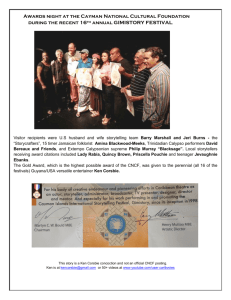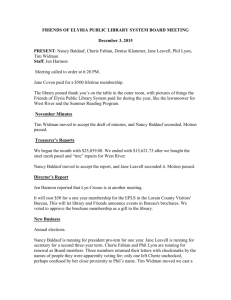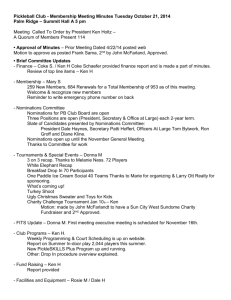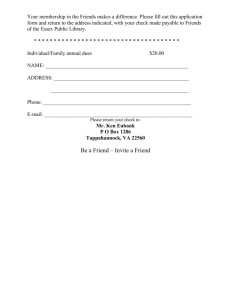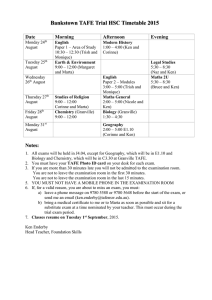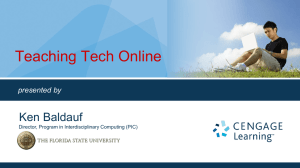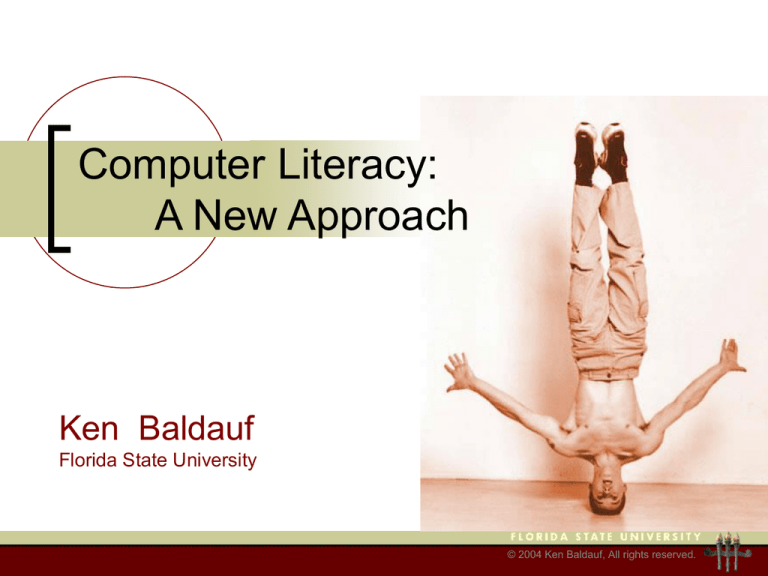
Computer Literacy:
A New Approach
Ken Baldauf
Florida State University
© 2004 Ken Baldauf, All rights reserved.
Session Topics
Computer Literacy: A Retrospective
College Requirements
Curriculum Considerations
The State of Technology
Job Market Demands
Today’s Technically Savvy Student
Computer Literacy Defined
A New Approach
© 2004 Ken Baldauf, All rights reserved.
Professional Profile
Ken Baldauf
FSU Computer Science faculty member
BA in Music, MS in Computer Science
Eight years teaching Computer Literacy @
FSU
Over 5,000 students annually
CGS2060: Computer Literacy
CGS2100: MicroApps for Business
Assisted by 30 teaching assistants
© 2004 Ken Baldauf, All rights reserved.
Computer Literacy:
A Retrospective
Stretching to
Accommodate Trends
and Growth
© 2004 Ken Baldauf, All rights reserved.
Computer Literacy Circa 1996
Traditional Definition
Computer Literacy: A working
knowledge of personal computers
Skills focused
Supported by Concepts
© 2004 Ken Baldauf, All rights reserved.
Computer Literacy Circa1996
Traditional Definition
Skills
Concepts
DOS/Windows
File Management
Email (Elm)
Internet/Web
MS Works
Word Processing
Spreadsheets
Databases
PC Components
PC Software
PC Multimedia
LAN
The Internet & Web
Security
© 2004 Ken Baldauf, All rights reserved.
Changes Over Time
1996
1997
1998
1998
Implemented computer-based
concepts testing
Moved to MS Office
Added Web-based versions to
accommodate experienced students
and classroom space issues.
Organizational restructuring.
Implemented computer-based skills
testing. Goal: consistent exams across
classes and teachers
© 2004 Ken Baldauf, All rights reserved.
Changes Over Time
1999
Started using Blackboard
2000
FSU implemented Computer
Competency Requirement –
developed university-wide testing
system.
Moved from Office textbooks to CBT.
2002
What’s Next?
© 2004 Ken Baldauf, All rights reserved.
College Requirements
Setting the Bar
© 2004 Ken Baldauf, All rights reserved.
College Requirements
University’s and accreditation agencies have
recognized the value of computer
knowledge and skills in all career areas.
Requirements are being imposed to verify
that students are acquiring computer
knowledge and skills prior to graduation.
Does your institution have
such a requirement?
© 2004 Ken Baldauf, All rights reserved.
FSU’s Requirements
FSU’s Computer Skills Competency Requirement
All undergraduates at The Florida State University
must demonstrate basic computer competency
prior to graduation. The computer competency
requirement may be satisfied be taking an
approved course, or exam. Regardless of the
vehicle used to satisfy the computer competency
requirement, students must demonstrate:
© 2004 Ken Baldauf, All rights reserved.
FSU’s Requirement
Basic familiarity with computer hardware,
operating systems, and file concepts;
Working knowledge of a word processor or
text editor and at least one other software
application (e.g., spreadsheet, database,
etc.); and
Working knowledge of the World WideWeb
(WWW) and electronic mail.
© 2004 Ken Baldauf, All rights reserved.
OSU’s Requirement
Oklahoma State Regents for
Higher Education policy requires
that students …must demonstrate computer
proficiency for graduation with a bachelors
degree. These skills include word
processing, spreadsheet, email, and web
use.
© 2004 Ken Baldauf, All rights reserved.
USU’s Requirements
Ethics Test
Email Test
Operating Systems Test
Document Processing Test
Information Resources Test
Spreadsheets Test
© 2004 Ken Baldauf, All rights reserved.
NC State’s Requirement
The following may be used to fulfill
computer literacy instruction:
instruction and assignments required
within courses, and/or
required use of a computer to complete
assignments.
© 2004 Ken Baldauf, All rights reserved.
Princeton’s Requirements
No computer requirement or intro
applications course.
One gen ed course: Computer Science
109:Computers in Our World taught by
Brian Kernighan (inventor of C)
Princeton provides applications training
through Resident Computer Coordinators
(RCCs) that assist students with
computing questions.
© 2004 Ken Baldauf, All rights reserved.
College Requirements
min
Clearly colleges have differing
opinions on what computer literacy is
and what should be required of their
students.
max
© 2004 Ken Baldauf, All rights reserved.
The Problem
College-wide requirements tend to
result in:
Lowest common denominator
specifications with minimal
expectations
Lots of administrative overhead
© 2004 Ken Baldauf, All rights reserved.
FSU’s Solution
Move the responsibility of defining
computer literacy down to the
department level, subject to college
approval.
Departments may select already
approved courses or develop one of
their own.
© 2004 Ken Baldauf, All rights reserved.
College Requirements
Requirements will come and go.
They will require less than we, the
experts in the field, feel is appropriate.
Our focus should be on providing our
students with the knowledge and skills
that we believe they will need through
our courses and teaching.
© 2004 Ken Baldauf, All rights reserved.
Designing the Course
Influences on the design of a
Computer Literacy class include:
An evaluation of the relative importance
of varying aspects of technology
Goals of the institution - the target job
market
Knowledge of the student’s level of
experience
© 2004 Ken Baldauf, All rights reserved.
Evaluating The State
of Technology
These are the days
of miracles and
wonders….
© 2004 Ken Baldauf, All rights reserved.
Yesterday’s PC
© 2004 Ken Baldauf, All rights reserved.
Today’s PC
Gateway’s Gaming PC
© 2004 Ken Baldauf, All rights reserved.
Today’s PC
Gateway’s Profile 5
© 2004 Ken Baldauf, All rights reserved.
Today’s PC
Gateway’s Media PC
© 2004 Ken Baldauf, All rights reserved.
Today’s PC
Apple PowerBook G4
© 2004 Ken Baldauf, All rights reserved.
Today’s PC
Tablet PC
© 2004 Ken Baldauf, All rights reserved.
Today’s PC
Flip-start from Vulcan
© 2004 Ken Baldauf, All rights reserved.
Today’s PC
PalmOne’s Treo-600
© 2004 Ken Baldauf, All rights reserved.
Today’s PC
The PC has morphed into a variety
information appliances of every size
for every need with a strong focus on
the ability to connect.
© 2004 Ken Baldauf, All rights reserved.
Connecting
Wireless connectivity makes it possible to
access information from servers or
individuals anywhere, anyplace, anytime.
W-fi, Bluetooth & Ad-hoc Wireless Networks
© 2004 Ken Baldauf, All rights reserved.
Connecting
The SmartPhone
Bridging Phone/Internet
Pervasive Communications
M-commerce
© 2004 Ken Baldauf, All rights reserved.
Connecting
The power of connecting is
transforming our society.
© 2004 Ken Baldauf, All rights reserved.
Connecting
Joseph Estrada leaves the
presidential palace on Jan. 20,
2001 after resigning earlier in the
day.
Jan 20, 2001, Philippines: More than 1 million Manila residents,
mobilized and coordinated by waves of text messages,
peacefully toppled the regime.
© 2004 Ken Baldauf, All rights reserved.
Sentient Things
Cutting Board Web Browser
HP’s SPECs (Small Personal
Everyday Computer)
© 2004 Ken Baldauf, All rights reserved.
Sentient Things
RFID: Giving material objects memory and a voice.
© 2004 Ken Baldauf, All rights reserved.
Sentient Things
From Howard
Rheingold’s
“Smart Mobs”
Information and communications
technologies are starting to invade the
physical world. Shards of sentient silicon
will be inside boxtops and dashboards,
pens, street corners, bus stops, money,
most things manufactured or built, within
the next 10 years. A shirt label will gain the
power to disclose what airplanes, trucks,
and ships carried it, what substances
compose it, and the URL of the webcam in
the factory where the shirt was
manufactured.
© 2004 Ken Baldauf, All rights reserved.
Sentient Things
About the size of a grain
of rice, the VeriChip is
injected beneath the
skin and transmits a
unique 125-kilohertz
radio frequency signal.
Solusat, the Mexican
distributor of the
VeriChip, is marketing
the device as an
emergency ID tag under
its new VeriKid program.
© 2004 Ken Baldauf, All rights reserved.
Pervasive Digital Photography
© 2004 Ken Baldauf, All rights reserved.
GPS
Global Positioning System (GPS)
Showing us the best route and keeping
track of kids.
Wherify GPS Locator for Children
© 2004 Ken Baldauf, All rights reserved.
Virtual and Augmented Reality
Augmented Reality: The layering
of additional information over
sensory input.
© 2004 Ken Baldauf, All rights reserved.
The State of techology…
…has dramatically changed since 1996.
Centering a curriculum
around the Desktop PC
seriously under-equips
students for the challenges
they will face.
© 2004 Ken Baldauf, All rights reserved.
Work/Life Demands
Preparing Students to
shoulder the load
© 2004 Ken Baldauf, All rights reserved.
Microsoft Office
Microsoft Office skills remain overwhelmingly the
most desirable application skills for non-IT staff.
A search on Monster.com turns up over 5,000 hits
each for keywords “Word”, “Excel”, “Access”, and
“Powerpoint”.
Office also serves
well to illustrate to
students four
primary uses of
computers
Program
Computational Function
Word
Document Production
Excel
Mathematical and Logical
Calculations
Access
Data Storage and Manipulation
PowerPoint
Vector (Object-Oriented) Graphics
© 2004 Ken Baldauf, All rights reserved.
Certification
Employers hiring in positions that
depend on specific application skills
like to have proof of skills.
“College certified” may be a cheaper
alternative.
© 2004 Ken Baldauf, All rights reserved.
Beyond Microsoft Office
Many careers also require familiarity with a variety
of digital communications and networking
technologies:
Internet, Email, IM, Web
LAN, Intranet
Virtual Private Network (VPN)
Wi-fi
Voice over IP
SmartPhone Technologies
College graduates require a technology comfortlevel that exceeds that acquired through casual
use.
© 2004 Ken Baldauf, All rights reserved.
Beyond Microsoft Office
Many careers require computer skills other
than Microsoft Office:
Personal Information Management
Web Development
Graphics
Animation
© 2004 Ken Baldauf, All rights reserved.
Programming Skills?
An understanding of system and application
development demonstrates problem-solving skills.
Non-tech users are becoming increasingly involved
in system and software development in businesses
and organizations. Why?
They understand the problems at hand
They are increasingly technically savvy
Software development tools are increasingly easier to use
Programmers are not able to keep up with organization
demands
© 2004 Ken Baldauf, All rights reserved.
Technology @ Home
An understanding of digital technologies is
equally important in our personal lives:
High Speed Internet Access
Home Wi-fi Networking
Digital photography and video
Digital Entertainment Media
The complexity of digital technology is
outpacing the industry’s ability to make it
“user frienly”.
© 2004 Ken Baldauf, All rights reserved.
Summary
Information and communication
technologies are integral to the success of
businesses and individuals.
Employers in all career areas realize the
importance of an employee’s ability to
APPLY computer knowledge to resolve
problems and increase effectiveness and
efficiency.
© 2004 Ken Baldauf, All rights reserved.
Technically Savvy Student
© 2004 Ken Baldauf, All rights reserved.
Know Your Students
Survey of my 2,200 incoming students
revealed:
100% have used Email
99% have used Microsoft Word
96% of students own computers
88% have used Instant Messaging
53% have used Microsoft Excel
69% have used Microsoft PowerPoint
90% of students own cell phones
51% use SMS text messaging
71% of students acquire their music from file-sharing
networks or from friends
Only 27% purchase music new on CD
© 2004 Ken Baldauf, All rights reserved.
Computer Literacy
Seeking the
one true definition
© 2004 Ken Baldauf, All rights reserved.
National Study
Report: Being Fluent with Information
Technology - 1999
National Research Council,
Committee on Information Technology Literacy
“Literacy is too modest a goal in the presence of rapid
change, because it lacks the necessary "staying power.“
As the technology changes by leaps and bounds,
existing skills become antiquated and there is no
migration path to new skills. ”
© 2004 Ken Baldauf, All rights reserved.
FITness Report
“Fluency with information technology entails a
process of lifelong learning in which individuals
continually apply what they know to adapt to change
and acquire more knowledge to be more effective at
applying information technology to their work and
personal lives.”
“Fluency with information technology requires three
kinds of knowledge:
contemporary skills,
foundational concepts, and
intellectual capabilities.”
© 2004 Ken Baldauf, All rights reserved.
Concerns about FITness
The general approach presented in FITness
is solid (skills, concepts, capabilities).
The amount of skills and concepts included
in the approach require twice the amount of
time as traditional intro classes.
Some implementations of FITness include
significant amounts of programming.
© 2004 Ken Baldauf, All rights reserved.
Designing A New Approach
Bending Over Backwards
for Our Students
© 2004 Ken Baldauf, All rights reserved.
Desirable Skills
What skills should
we be teaching to
non-tech majors?
Consider all
possible intro-level
skills and student
interests.
Windows and/or Mac
File Management
Email
Outlook (PIM)
Web Research
Word Processing
Web Authoring with
GUI
Spreadsheets
Databases
PowerPoint
Graphics (Adobe
Illustrator)
Digital Photo Editing
(Photoshop)
HTML/Dreamweaver
Macromedia Flash
JavaScript
Data Access Pages
© 2004 Ken Baldauf, All rights reserved.
Familiar Skills
Consider providing
outside-of-class
tutorials for skills that
are familiar to most
students.
Provide a study guide
and test for all
students.
Windows and/or Mac
File Management
Email
Outlook (PIM)
Web Research
Word Processing
Web Authoring with
Word or Netscape
Speadsheets
Databases
PowerPoint
Graphics (Adobe
Illustrator)
Digital Photo Editing
(Photoshop)
HTML/Dreamweaver
Macromedia Flash
JavaScript
Data Access Pages
© 2004 Ken Baldauf, All rights reserved.
Combining Skills
Combining applications
into projects demonstrates
the interoperability of
software and skills.
Web research, word
processing, and Web
authoring combine for an
interesting project.
Windows and/or Mac
File Management
Email
Outlook (PIM)
Web Research
Word Processing
Web Authoring with
Word or Netscape
Speadsheets
Databases
PowerPoint
Graphics (Adobe
Illustrator)
Digital Photo Editing
(Photoshop)
HTML/Dreamweaver
Macromedia Flash
JavaScript
Data Access Pages
© 2004 Ken Baldauf, All rights reserved.
Combining Skills
The PowerPoint
assignment can be used
to demonstrate integration
between Office
applications (created with
an outline in Word, import
an excel chart).
Graphics and Web
development are naturally
complimentary skills.
Web Design
Windows and/or Mac
File Management
Email
Outlook (PIM)
Web Research
Word Processing
Web Authoring with
Word or Netscape
Speadsheets
Databases
PowerPoint
Graphics (Adobe
Illustrator)
Digital Photo Editing
(Photoshop)
HTML/Dreamweaver
Macromedia Flash
JavaScript
Data Access Pages
© 2004 Ken Baldauf, All rights reserved.
Some skills can be offered
ala carte, keeping the
basic core skills
mandatory.
Choose 2
Choose 1
Ala Carte Skills
Required
Windows and/or Mac
File Management
Email
Outlook (PIM)
Web Research
Word Processing
Web Authoring with
Word or Netscape
Speadsheets
Databases
PowerPoint
Graphics (Adobe
Illustrator)
Digital Photo Editing
(Photoshop)
HTML/Dreamweaver
Macromedia Flash
JavaScript
Data Access Pages
© 2004 Ken Baldauf, All rights reserved.
Tracks
Special-focus tracks can
be designed.
MS Office Track
Graphics Track
Web Development
Database/Web Dev
Required
Windows and/or Mac
File Management
Email
Outlook (PIM)
Web Research
Word Processing
Web Authoring with
Word or Netscape
Speadsheets
Databases
PowerPoint
Graphics (Adobe
Illustrator)
Digital Photo Editing
(Photoshop)
HTML/Dreamweaver
Macromedia Flash
JavaScript
Data Access Pages
© 2004 Ken Baldauf, All rights reserved.
2 Course Sequence
Comp Lit 1
Create a two course
sequence. Students that
complete both courses will
have a powerful arsenal of
skills.
Comp Lit 2
Windows and/or Mac
File Management
Email
Outlook (PIM)
Web Research
Word Processing
Web Authoring with
Word or Netscape
Speadsheets
Databases
PowerPoint
Graphics (Adobe
Illustrator)
Digital Photo Editing
(Photoshop)
HTML/Dreamweaver
Macromedia Flash
JavaScript
Data Access Pages
© 2004 Ken Baldauf, All rights reserved.
Concepts
“Concepts” provide the foundation
from which a real understanding of
digital technologies and information
systems can arise.
Information System and Digital Electronics Concepts
© 2004 Ken Baldauf, All rights reserved.
Concepts
It is the “Concepts” portion of the course
that provides students with an
understanding of important technologies.
Computing
Platforms
Digital Media
Digital
Communications
New Technologies
Wireless
Social Implications
Networks
The world(s)
around us
Information System and Digital Electronics Concepts
© 2004 Ken Baldauf, All rights reserved.
Concepts
Most importantly, “Concepts” assist students in
understanding how to apply technology,
information systems, and skills toward their
personal and professional success.
Information System and Digital Electronics Concepts
© 2004 Ken Baldauf, All rights reserved.
Concepts
Digital Data Representation
Hardware
Software
Networking
Information System and Digital Electronics Concepts
© 2004 Ken Baldauf, All rights reserved.
Concepts
Internet/Web
Info Security/Ethics
Multimedia
Database/Info Mng
Information System and Digital Electronics Concepts
© 2004 Ken Baldauf, All rights reserved.
Concepts
E-commerce
Information Systems
Sys/Prog Dev
Information System and Digital Electronics Concepts
© 2004 Ken Baldauf, All rights reserved.
Concepts can be boring…
…or they can REVEAL important insight
for your students.
WARNING!
Cheesy Mnemonic
Approaching
Those with little tolerance
for Cheesy Mnemonics
should momentarily close
their eyes and cover their
ears.
WARNING!
© 2004 Ken Baldauf, All rights reserved.
Concepts can be boring…
…or they can REVEAL important insight
for your students.
Relevant – Cover contemporary Issues of interest to the students,
pertinent to their future careers.
Examples – Show students how technology is assisting others
professionally and personally.
Valuable – Omit any topics that aren’t of relative value. Bits and Bytes
are of value, ISA, PCI, and AGP slots are not.
Energize – Energize your lectures with guest speakers, games, and
group discussions. Pop quizzes don’t hurt either.
All Encompassing – Avoid platform bias. Cover everything from Super
computers to SmartPhones.
Love
Love what you do! Enthusiasm is contagious!!
© 2004 Ken Baldauf, All rights reserved.
The New Approach
@ FSU
© 2004 Ken Baldauf, All rights reserved.
The New Approach
Two semesters of Computer Literacy:
CompLit 1 and CompLit 2
CompLit 1 (or equivalent) a
prerequisite for CompLit 2
Departments can require one or both
for their students
© 2004 Ken Baldauf, All rights reserved.
CompLit 1 & CompLit 2
CompLit 1 Skills
Microsoft Windows
Managing Files
E-mail
Web Research
Microsoft Word
Microsoft Excel
Microsoft Access
Microsoft PowerPoint
Application Integration
Creating a Webpage
with Word
CompLit 2 Skills
Intro to Unix
Web Authoring: Intro to
XHTML
Macromedia
DreamWeaver
Macromedia Fireworks
Macromedia Flash
Microsoft Access
Data Access Pages
Intro to JavaScript
© 2004 Ken Baldauf, All rights reserved.
CompLit 1 & CompLit 2
CompLit 1 Concepts
Digital Data
Representation
Hardware
Software
Networking
Internet/Web
Multimedia
Info Security/Ethics
CompLit 2 Concepts
Database Systems
E-commerce
Computer Graphics
Multimedia
Information Systems
Systems Development
Software Development
Info Security/Ethics
© 2004 Ken Baldauf, All rights reserved.
Goal
Students who complete both courses
will have the technical skills and
understanding needed to succeed and
an awesome resume!
© 2004 Ken Baldauf, All rights reserved.
The New Approach Summary
Skills
Play to the majority, outsource the
deficiencies
Provide for interests other than MS Office
Build a general understanding of
computer capabilities
© 2004 Ken Baldauf, All rights reserved.
The New Approach Summary
Concepts
Use a “digital technology” focus.
Devote time to technologies relative to
their importance in today’s society.
Focus on usability with plenty of
examples.
Illustrate how technology empowers
individuals in professional and personal
endeavors.
© 2004 Ken Baldauf, All rights reserved.
Thanks for your time.
Questions?
Feel free to pick up handouts on your way out:
The New Approach Specifications
“News Resources for Tech Teachers” reference sheet
Ken Baldauf
Florida State University
baldauf@cs.fsu.edu
850-644-5832
http://lit.cs.fsu.edu
http://www.kenbaldauf.com
© 2004 Ken Baldauf, All rights reserved.
Web References
FSU’s Computer Literacy Website
http://lit.cs.fsu.edu
Ken Baldauf’s Professional Website
http://www.kenbaldauf.com
FSU’s Computer Skills Requirement
http://websrv.cs.fsu.edu/academics/compcomp.html
Oklahoma State’s Requirement
http://cheminfo.chem.ou.edu/undergraduate/complit.html
Utah State’s Computer Technology Tests
http://cil.usu.edu/comptech/
NC State’s Requirement
http://www.ncsu.edu/provost/academic_programs/ger/cominfo/req.htm
Princeton’s Computer Science 109:Computers in Our World
http://www.cs.princeton.edu/courses/archive/fall03/cs109/
The Media Center PC
http://www.microsoft.com/windowsxp/mediacenter/default.asp
© 2004 Ken Baldauf, All rights reserved.
Web References
The Tablet PC
http://www.microsoft.com/windowsxp/tabletpc/default.asp
FlipStart PC from Vulcan
http://www.flipstartpc.com
Bluetooth
http://www.bluetooth.com
M-Commerce for All
http://www.theregister.co.uk/content/archive/29477.html
"The Cell Phone and the Crowd: Messianic Politics in the
Contemporary Philippines"
http://communication.ucsd.edu/people/f_rafael_cellphonerev_files.htm
HP’s SPECs (Small Personal Everyday Computer) - ubiquitous
http://www.fireflydesign.com/consulting/computing.pdf
RFID
http://www.rfidjournal.com/
© 2004 Ken Baldauf, All rights reserved.
Web References
Tracking Junior With a Microchip
http://www.wired.com/news/technology/0,1282,60771,00.html
Applied Digital Solutions (Verichip, and Digital Angel)
http://www.adsx.com/index.html
Smart Mobs
http://www.smartmobs.com
Wherify GPS Locator for Children
http://www.wherifywireless.com/corp_home.htm
Augmented Reality
http://hci.rsc.rockwell.com/AugmentedReality/
“Being Fluent with Information Technology” Report
http://books.nap.edu/html/beingfluent/
© 2004 Ken Baldauf, All rights reserved.

